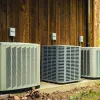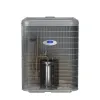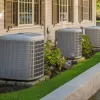The last time you purchased an AC, you probably considered the unit’s SEER before deciding to buy it.
SEER rating, of course, is a standard for gauging an air conditioner’s efficiency. It’s an acronym for “seasonal energy efficiency ratio” with higher SEER numbers indicating a more efficient AC.
But starting on January 1, 2023, SEER won’t be the standard anymore. Instead, every new AC will receive a SEER2 rating.
A higher SEER2 will still be more efficient than a lower SEER2. However, SEER2 is calculated much differently from SEER. It’s an all-new standard.
What is SEER2 all about?
The whole point of SEER2 is to make up for deficiencies in the way SEER was calculated.
You see, the US Department of Energy (DOE) sets the standards for appliance efficiency and issues extremely precise guidance on how manufacturers need to calculate the relative efficiency of their equipment. The standards for SEER were established many years ago, and manufacturers have been abiding by them ever since. However, there were always problems with SEER.
According to a recent report in ACHR, the DOE created SEER2 to better align AC efficiency ratings with real-world operating conditions:
An updated test procedure, intended to reflect field condition [sic] more accurately, is driving the new “2” ratings. The new M1 testing regimen includes changes for minimum air handler static pressure; fan power for coil-only units; heating load calculation; heating mode test; variable-speed factor for SEER2 ratings; and off-mode power test.
In other words, the way SEER considers static pressure as part of its overall calculation isn’t realistic. SEER2 still accounts for static pressure, but in a way that’s more in line with how systems are set up out in the wild (e.g., your house).
That’s cool. But how does SEER2 affect me?
Glad you asked! The overall effect of SEER2 is to make air conditioners more efficient. It’s kind of like when the DOE increased the minimum SEER in years past, only this time they also moved the goalposts.
That being the case, SEER2 will affect you in the following ways:
- Every AC available for purchase in the Southeast (that’s our region) starting in 2023 will have a minimum SEER2 of 14.3. This equates to 15 SEER under the current system, so the least efficient unit you can buy in 2023 will be more efficient than the least efficient unit you can buy in 2022. (Minimum SEER2 for Southwestern states will also be 14.3; for Northern states, the minimum SEER2 will be 13.4).
- New air conditioners will be more expensive. It just costs more to manufacture a more efficient system. Facts of life, right?
- If you’re buying a new air conditioner in 2022, you’ll have to decide whether it makes sense to install a new 14 SEER unit.
Let’s focus on the third point. Price-conscious buyers might be tempted to replace their old, dying air conditioner with a less expensive 14 SEER system while they still have the option. And let’s be clear: it will cost less than getting a 14.3 SEER2 system in 2023.
However, that 14 SEER AC could land you in a bit of trouble if you want to sell your house soon.
Back when the DOE raised the minimum SEER from 10 to 13 in 2006, we saw a lot of buyer’s remorse among people who had just installed SEER 10 units in the last couple of years. During the process of selling their homes, real estate agents were telling potential buyers that the air conditioners, while new, weren’t compliant with the current energy efficiency standards. Buyers were demanding that sellers swap out the still-new ACs for even newer ones with a higher SEER.
You could end up in a similar situation. If you don’t want that to happen to you, your best bet will be to purchase a SEER 15 or 16 unit before SEER2 goes into effect. The minimum SEER2 of 14.3 equates to SEER 15 under the current standard, so getting a slightly more efficient unit today will leave you in the clear after January 1, 2023.
Remember that SEER and SEER2 aren’t the final word on AC efficiency
While SEER and SEER2 are factors you should consider when shopping for an air conditioner, other characteristics have a major impact on efficiency.
We’re talking about the AC speeds, sometimes referred to as stages.
Most air conditioners are standard, single-speed units. They turn on to cool the home, run at full blast the whole time they’re going, and then cut off when the thermostat is happy. This is probably how your current AC works.
Two-speed ACs are more efficient. They run at a low speed most of the time and only change over to the full blast setting on really hot days or if someone lowers the temperature on the thermostat by several degrees. By running at a lower speed and cooling less air, the two-speed system maintains comfortable temperatures in your home while demanding less power than a standard, single-speed unit.
Then there are variable speed air conditioners. SEER and SEER2 aside, variable speed units are going to offer the best efficiency for most people, most of the time.
That’s because variable speed units ramp up and down to match the exact cooling needs of your home at any given time. On most days, they’ll run at lower speeds throughout the day. They might even keep running for almost an entire day without turning it off!
This is a good thing. Standard ACs’ biggest power draw happens when they start running for a cycle. Variable speed units don’t start up all that often, so they use less power. Then, while they are running, it’s usually at a low speed. Again: less cooling, less power.
Since two-speed and variable speed units run for longer cycles, they also remove more humidity from homes than standard ACs. With a standard unit, people are often tempted to run it more often to deal with the lingering humidity between cycles. As a result, the AC starts up more often and runs at a high speed for a longer period. Neither of these things happens with a two-speed or variable-speed AC.
The point of all this is to help you understand that there’s more to AC efficiency than just SEER or SEER2. You’ve got to consider the speed or speeds of the AC as well.
Go forth and use these SEER2 insights to your advantage!
If you’re not on the cusp of an air conditioner replacement right now, you might not care all that much about SEER vs. SEER2. That’s fine. You can think more about SEER2 whenever it does come time to replace your AC.
But if you are thinking about getting a new unit this year, you’ve got a decision to make! You can go the less expensive route and get a 14 SEER system, or you can get a 15 or 16 SEER unit to ensure you’re compliant with the upcoming SEER2 guidelines.
The choice of AC depends heavily on a lot of factors, and efficiency and price are just two of several. Use this information to your advantage, so you can make the best choice for your home!






